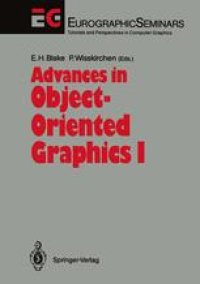
Ebook: Advances in Object-Oriented Graphics I
- Tags: Computer Graphics, Programming Languages Compilers Interpreters, Computer-Aided Engineering (CAD CAE) and Design
- Series: EurographicSeminars
- Year: 1991
- Publisher: Springer-Verlag Berlin Heidelberg
- Edition: 1
- Language: English
- pdf
Object-oriented systems have gained a great deal of popularity recently and their application to graphics has been very successful. This book documents a number of recent advances and indicates numerous areas of current research. The purpose of the book is: - to demonstrate the extraordinary practical utility of object-oriented methods in computer graphics (including user interfaces, image synthesis, CAD), - to examine outstanding research issues in the field of object-oriented graphics, and in particular to investi- gate extensions and shortcomings of the methodology when applied to computer graphics. Papers included in the book extend existing object-oriented graphical techniques, such as Smalltalk's "model view controller" or "constraints", introduce the use of complex and persistent objects in graphics, and give approaches to direct manipulation interfaces. The reader is presented with an in-depth treatment of a number of significant existing graphics systems, both for user interfaces and for image synthesis. There are theoretical surveys and chapters pointing to new directions in the broad field of computer graphics. Computer language scientists will find a useful critique of object-oriented language constructs and suggested ways to extend object-oriented theory.
Object-oriented systems have gained a great deal of popularity recently and their application to graphics has been very successful. This book documents a number of recent advances and indicates numerous areas of current research. The purpose of the book is: - to demonstrate the extraordinary practical utility of object-oriented methods in computer graphics (including user interfaces, image synthesis, CAD), - to examine outstanding research issues in the field of object-oriented graphics, and in particular to investi- gate extensions and shortcomings of the methodology when applied to computer graphics. Papers included in the book extend existing object-oriented graphical techniques, such as Smalltalk's "model view controller" or "constraints", introduce the use of complex and persistent objects in graphics, and give approaches to direct manipulation interfaces. The reader is presented with an in-depth treatment of a number of significant existing graphics systems, both for user interfaces and for image synthesis. There are theoretical surveys and chapters pointing to new directions in the broad field of computer graphics. Computer language scientists will find a useful critique of object-oriented language constructs and suggested ways to extend object-oriented theory.
Object-oriented systems have gained a great deal of popularity recently and their application to graphics has been very successful. This book documents a number of recent advances and indicates numerous areas of current research. The purpose of the book is: - to demonstrate the extraordinary practical utility of object-oriented methods in computer graphics (including user interfaces, image synthesis, CAD), - to examine outstanding research issues in the field of object-oriented graphics, and in particular to investi- gate extensions and shortcomings of the methodology when applied to computer graphics. Papers included in the book extend existing object-oriented graphical techniques, such as Smalltalk's "model view controller" or "constraints", introduce the use of complex and persistent objects in graphics, and give approaches to direct manipulation interfaces. The reader is presented with an in-depth treatment of a number of significant existing graphics systems, both for user interfaces and for image synthesis. There are theoretical surveys and chapters pointing to new directions in the broad field of computer graphics. Computer language scientists will find a useful critique of object-oriented language constructs and suggested ways to extend object-oriented theory.
Content:
Front Matter....Pages I-X
Front Matter....Pages 1-1
An Object-Oriented Framework for Direct-Manipulation User Interfaces....Pages 3-19
Snap Together Mathematics....Pages 21-34
Building User Interfaces with the LOOKS Hyper-Object System....Pages 35-46
A Layered Object-Oriented Model for Interaction....Pages 47-65
A 2-D Graphics System for Multi-User Interactive Graphics Based on Objects and Constraints....Pages 67-91
Front Matter....Pages 93-93
Persistent Graphical Objects....Pages 95-115
Retrospective Creation of Virtual Alternative Hierarchies....Pages 117-129
Coordinate Frames and Geometric Approximation in Graphics Object Oriented Programming....Pages 131-147
A Direct Manipulation Environment for Conceptual Design of Three Dimensional Objects....Pages 149-174
Front Matter....Pages 175-175
The Design of the Dor? Graphics System....Pages 177-198
The New Graphics Standard — Object-Oriented!....Pages 199-215
Back Matter....Pages 217-220
Object-oriented systems have gained a great deal of popularity recently and their application to graphics has been very successful. This book documents a number of recent advances and indicates numerous areas of current research. The purpose of the book is: - to demonstrate the extraordinary practical utility of object-oriented methods in computer graphics (including user interfaces, image synthesis, CAD), - to examine outstanding research issues in the field of object-oriented graphics, and in particular to investi- gate extensions and shortcomings of the methodology when applied to computer graphics. Papers included in the book extend existing object-oriented graphical techniques, such as Smalltalk's "model view controller" or "constraints", introduce the use of complex and persistent objects in graphics, and give approaches to direct manipulation interfaces. The reader is presented with an in-depth treatment of a number of significant existing graphics systems, both for user interfaces and for image synthesis. There are theoretical surveys and chapters pointing to new directions in the broad field of computer graphics. Computer language scientists will find a useful critique of object-oriented language constructs and suggested ways to extend object-oriented theory.
Content:
Front Matter....Pages I-X
Front Matter....Pages 1-1
An Object-Oriented Framework for Direct-Manipulation User Interfaces....Pages 3-19
Snap Together Mathematics....Pages 21-34
Building User Interfaces with the LOOKS Hyper-Object System....Pages 35-46
A Layered Object-Oriented Model for Interaction....Pages 47-65
A 2-D Graphics System for Multi-User Interactive Graphics Based on Objects and Constraints....Pages 67-91
Front Matter....Pages 93-93
Persistent Graphical Objects....Pages 95-115
Retrospective Creation of Virtual Alternative Hierarchies....Pages 117-129
Coordinate Frames and Geometric Approximation in Graphics Object Oriented Programming....Pages 131-147
A Direct Manipulation Environment for Conceptual Design of Three Dimensional Objects....Pages 149-174
Front Matter....Pages 175-175
The Design of the Dor? Graphics System....Pages 177-198
The New Graphics Standard — Object-Oriented!....Pages 199-215
Back Matter....Pages 217-220
....